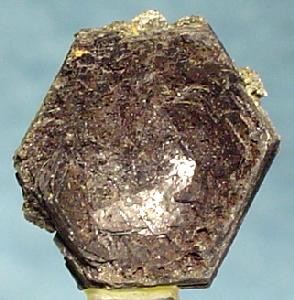The Mineral wurtzite

Wurtzite is a rare, high temperature polymorph of the common mineral Sphalerite. It forms at temperatures above 2192º F (1200º C) as hexagonal crystals.
An ornamental stone known as Schalenblende (an intergrowth of Wurtzite, Sphalerite, and often Galena) is usually referenced with Wurtzite but is more often listed as a variety of Sphalerite.
Chemical Formula
ZnS
This above is the formula for pure Wurtzite. However, since it often has some iron replacing the zinc, its formula is more accurately described as (Zn,Fe)S
Color
Light to dark brown
Properties
Streak
Light brown |
Hardness
3.5 - 4 |
Transparency
Translucent to nearly opaque |
Specific Gravity
4 |
Luster
Resinous |
Cleavage
2,1 - basal ; 3,1 - prismatic |
Fracture
Uneven |
Tenacity
Brittle |
Uses
Wurtzite is a very rare mineral, and only of value to scientists and mineral collectors. Schalenblende is used as a rare ornamental stone.
Noteworthy Localities
Large Wurtzite crystals come from two Bolivian mines: the San Jose Mine, Oruro; and the Siglo Veinte Mine, Llallagua, Potosi Department. Good European localities include Carrara, Tuscany, Italy; the Les Malines Mine, Saint-Laurent-le-Minier, Gard, France; Kirki, Thrace, Greece; and Pribram, Bohemia, Czech Republic. Wurtzite is also found in China in the Yaogangxian Mine, Hunan Province. A small finding of large, translucent, reddish-brown crystals, which many consider to be the best of species, have come from a recent find in the Merelani Hills, Arusha, Tanzania.
In the U.S., Wurtzite comes from Butte, Silver Bow Co., Montana; Frisco, Beaver Co., Utah; the Thomaston Dam, Litchfield Co., Connecticut; Negley, Columbiana Co., Ohio; and in the the lead mines of Reynolds Co., Missouri. Small amounts were also found in the Sterling Hill Mine in Ogdensburg, Sussex Co., New Jersey; and in Ellenville, Ulster Co., New York.
Distingushing Similar Minerals
Sphalerite - Differs in crystal form and cleavage.